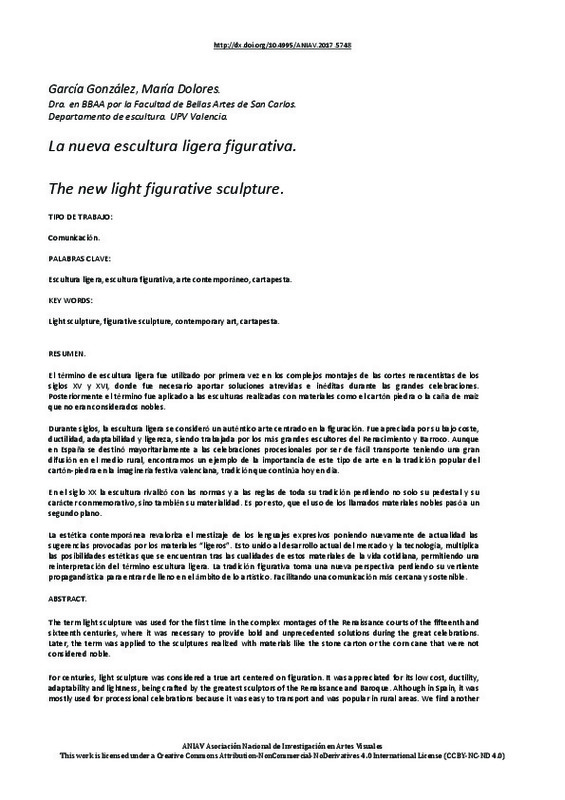|
Resumen:
|
[EN] The term light sculpture was used for the first time in the complex montages of the Renaissance courts of the fifteenth and sixteenth centuries, where it was necessary to provide bold and unprecedented solutions during ...[+]
[EN] The term light sculpture was used for the first time in the complex montages of the Renaissance courts of the fifteenth and sixteenth centuries, where it was necessary to provide bold and unprecedented solutions during the great celebrations. Later, the term was applied to the sculptures realized with materials like the stone carton or the corn cane that were not considered noble.
For centuries, light sculpture was considered a true art centered on figuration. It was appreciated for its low cost, ductility, adaptability and lightness, being crafted by the greatest sculptors of the Renaissance and Baroque. Although in Spain, it was mostly used for processional celebrations because it was easy to transport and was popular in rural areas. We find another example of the importance of this type of art in the popular tradition of stoneacarton in Valencian festive imagery, a tradition that continues today.
In the twentieth century, sculpture entered in contradiction with the norms and rules of its entire tradition, losing not only its pedestal and its commemorative character, but also its materiality. It is for this reason that the use of soacalled noble materials faded into the background.
Contemporary aesthetics revalue the mestization of expressive languages, putting the suggestions brought about by "light" materials back to the present day. This phenomenon, together with the current development of the market and technology, multiplies the aesthetic possibilities that lie behind the qualities of these daily life materials, allowing a reinterpretation of the term light sculpture. The tradition figurative takes a new perspective losing its propagandistic purpose to enter fully in the field of the artistic. Facilitating a closer and sustainable communication.
[-]
[ES] El término de escultura ligera, fue utilizado por primera vez en los complejos montajes de las cortes renacentistas de los siglos XV y XVI, donde fue necesario aportar soluciones atrevidas e inéditas durante las grandes ...[+]
[ES] El término de escultura ligera, fue utilizado por primera vez en los complejos montajes de las cortes renacentistas de los siglos XV y XVI, donde fue necesario aportar soluciones atrevidas e inéditas durante las grandes celebraciones. Posteriormente el término fue aplicado a las esculturas realizadas con materiales como el cartón piedra o la caña de maíz que no eran considerados nobles. Durante siglos, la escultura ligera se consideró un auténtico arte. Fue apreciada por su bajo coste, ductilidad, adaptabilidad y ligereza, siendo trabajada por los más grandes escultores del Renacimiento y Barroco. Aunque en España, se destinó mayoritariamente a las celebraciones procesionales por ser de fácil transporte teniendo una gran difusión en el medio rural, encontramos otro ejemplo de la importancia de este tipo de arte en la tradición del cartón-piedra en la imaginería festiva valenciana, tradición que continúa hoy en día. En el siglo XX la escultura rivalizó con las normas y a las reglas de toda su tradición perdiendo no solo su pedestal y su carácter conmemorativo, sino también su materialidad (Cerecera, 1999). Es por esto, que el uso de los llamados materiales nobles pasó a un segundo plano. La estética contemporánea revaloriza el mestizaje de los lenguajes expresivos poniendo nuevamente de actualidad las sugerencias provocadas por los materiales “ligeros”. Esto unido al desarrollo actual del mercado y la tecnología, multiplica las posibilidades estéticas que se encuentran tras las cualidades de estos materiales de la vida cotidiana, permitiendo una reinterpretación del término escultura ligera. La tradición toma una nueva perspectiva perdiendo su vertiente propagandística para entrar de lleno en el ámbito de lo artístico. Facilitando una comunicación más cercana y sostenible.
[-]
|









